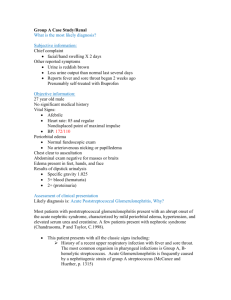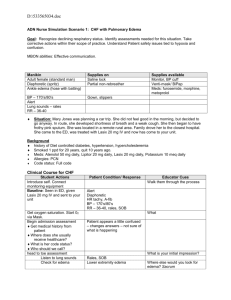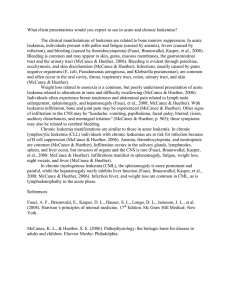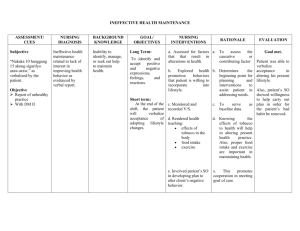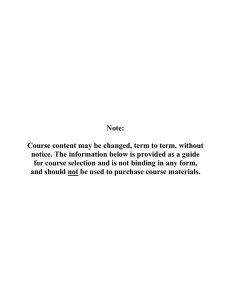Group 1 Edema doc.-Case Study 2
advertisement
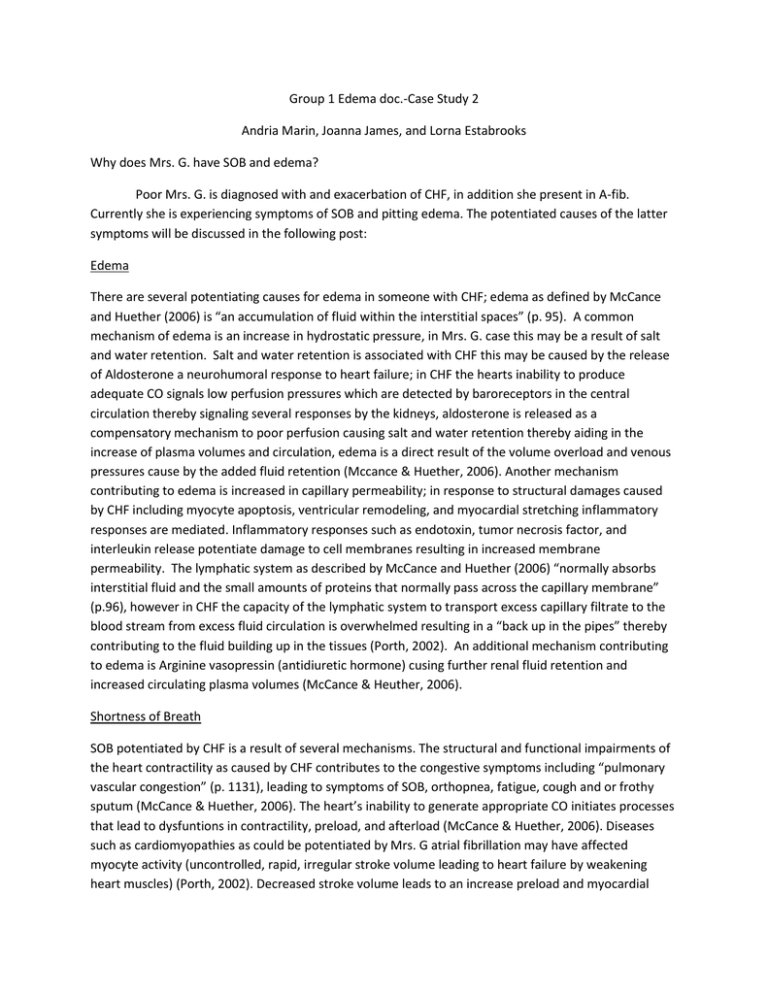
Group 1 Edema doc.-Case Study 2 Andria Marin, Joanna James, and Lorna Estabrooks Why does Mrs. G. have SOB and edema? Poor Mrs. G. is diagnosed with and exacerbation of CHF, in addition she present in A-fib. Currently she is experiencing symptoms of SOB and pitting edema. The potentiated causes of the latter symptoms will be discussed in the following post: Edema There are several potentiating causes for edema in someone with CHF; edema as defined by McCance and Huether (2006) is “an accumulation of fluid within the interstitial spaces” (p. 95). A common mechanism of edema is an increase in hydrostatic pressure, in Mrs. G. case this may be a result of salt and water retention. Salt and water retention is associated with CHF this may be caused by the release of Aldosterone a neurohumoral response to heart failure; in CHF the hearts inability to produce adequate CO signals low perfusion pressures which are detected by baroreceptors in the central circulation thereby signaling several responses by the kidneys, aldosterone is released as a compensatory mechanism to poor perfusion causing salt and water retention thereby aiding in the increase of plasma volumes and circulation, edema is a direct result of the volume overload and venous pressures cause by the added fluid retention (Mccance & Huether, 2006). Another mechanism contributing to edema is increased in capillary permeability; in response to structural damages caused by CHF including myocyte apoptosis, ventricular remodeling, and myocardial stretching inflammatory responses are mediated. Inflammatory responses such as endotoxin, tumor necrosis factor, and interleukin release potentiate damage to cell membranes resulting in increased membrane permeability. The lymphatic system as described by McCance and Huether (2006) “normally absorbs interstitial fluid and the small amounts of proteins that normally pass across the capillary membrane” (p.96), however in CHF the capacity of the lymphatic system to transport excess capillary filtrate to the blood stream from excess fluid circulation is overwhelmed resulting in a “back up in the pipes” thereby contributing to the fluid building up in the tissues (Porth, 2002). An additional mechanism contributing to edema is Arginine vasopressin (antidiuretic hormone) cusing further renal fluid retention and increased circulating plasma volumes (McCance & Heuther, 2006). Shortness of Breath SOB potentiated by CHF is a result of several mechanisms. The structural and functional impairments of the heart contractility as caused by CHF contributes to the congestive symptoms including “pulmonary vascular congestion” (p. 1131), leading to symptoms of SOB, orthopnea, fatigue, cough and or frothy sputum (McCance & Huether, 2006). The heart’s inability to generate appropriate CO initiates processes that lead to dysfuntions in contractility, preload, and afterload (McCance & Huether, 2006). Diseases such as cardiomyopathies as could be potentiated by Mrs. G atrial fibrillation may have affected myocyte activity (uncontrolled, rapid, irregular stroke volume leading to heart failure by weakening heart muscles) (Porth, 2002). Decreased stroke volume leads to an increase preload and myocardial stretching damaging sarcomeres and contractility, increased afterload is caused by increased in PVR as the heart works hard to overcome filling pressures caused by left ventricular hypertrophy (MccAnce & Huether, 2006). The damage caused by CHF leads to a stiff, fibrotic, non compliant heart with myocyte damage (McCance & Huether, 2006). In addition studies have shown that loss of vasodialatory properties occurs as a result of NO-redox imbalance mediated by the increased oxidative activity caused by heart failure in the vascular walls contributing to increased vasoconstriction (Lapu-Bula & Ofili, 2007). The hearts inability to function properly leads to poor CO and pulmonary congestion which would explain Mrs. G SOB. The fact that Mrs. G. stopped taking her water pills has worsened her CHF and contributed to her SOB and edema as this contributes to excess fluid overload with a heart and system that cannot manage it properly. Education and helping Mrs. G find treatment that works better for her lifestyle may promote compliance and improved CHF management. References Lapu-Bula, R. & Ofili, E. From hypertension to heart failure: Role of Nitric oxide-mediated endothelial dysfunction and emerging insights from myocardial contrast echocardiography, The American Journal of Cardiolgy (www.AJConine.org), 99(6B), 9D-14D. McCance, K.L., & Huether, S.E. (2006). Pathophysiology the biologic basis for disease in adults and children. (5th edition). Salt lake City, Utah: Elsevier Mosby. Porth, C.M. (2002) Pathophysiology concepts of altered health states (6th edition).Philadeplphia: Lpincott Williams & Willkins.

